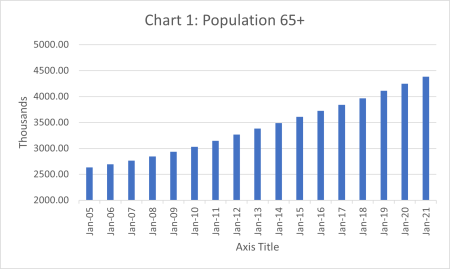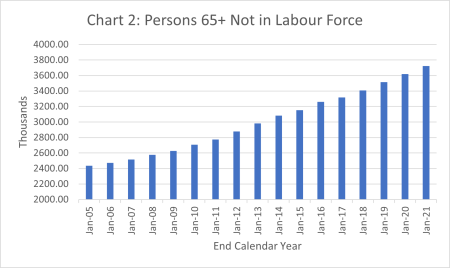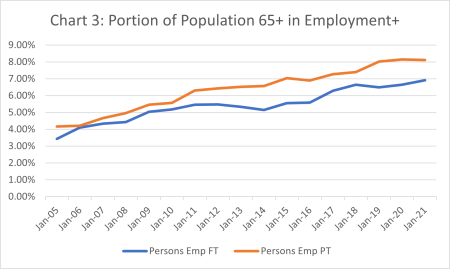The rate at which a growing elderly population continues to participate in the labour market will be critical to offsetting the negative impact of population ageing.
Like that of all developed nations, Australia’s population continues to age at an increasingly rapid rate albeit more slowly than other developed nations due to our higher rate of immigration. While the population 65+ was growing in the mid-2000s at around 60,000 per annum (see Chart 1), in more recent years it has been growing at over 130,000 per annum.
This will accelerate significantly over the next 10 to 15 years as the baby boomers age further before they start to die out at a faster rate from the 2030s.

In line with this growth, the number of people aged 65+ who are not participating in the labour force has also been rising at an increasing rate.
In the mid-2000s, the number of persons aged 65+ not participating in the labour force was increasing at around 35,000 per annum and in more recent years has been growing at around 110,000 per annum (see Chart 2).
By April 2022, the 65+ population not in the labour market was 3.8 million and on target to exceed 5 million by the end of this decade. Depending on the level and age structure of net migration, this may be within an overall population of less than 30 million by 2030 (one in six).
Note that this does not include people under 65 who have also left the labour market. In April 2022, there were another 578,296 people aged 60-64 who were not in the labour force taking the total number of people aged 60+ and not in the labour force to around 4.4 million.
This would partly be driven by the Howard Government policy to apply a zero rate of tax on superannuation earnings of people 60+ and in the pension phase of superannuation.
That policy means not only a loss of tax revenue on superannuation earnings but also reduced participation in the labour market and thus lower income tax revenue.
From the perspective of dealing with an ageing population, it was precisely what Australia should not have done although it may have garnered the Howard Government a significant number of votes from rich baby boomers who benefited from paying zero tax (as well as earning franking credits).

On the other hand, the rate of growth in people aged 65+ and not in the labour force has been slowed by the Rudd Government policy to increase the age at which they can access the age pension from 65 to 67. This forced people between the age of 65 and 67 to remain in the workforce longer than they may have otherwise, even if that meant they had to go onto JobSeeker.
The portion of the population aged 65+ that is employed has also been rising but at a slowing rate (see Chart 3). This is the case for both people aged 65+ in full-time employment which had reached almost 7% by 2022 and those in part-time employment which had reached over 8%.

While these portions may continue to rise due to people, mainly in white-collar jobs, remaining in the labour force longer, possibly doing part-time work, there will be limits to this for people in traditional trades and service jobs due to their physical nature.
So what is to be done?
A well targeted immigration policy will be essential to ensuring an adequate number of workers to support the growing number of elderly who are not in the workforce.
This will be required not only in terms of a larger health and aged care workforce but also to generate adequate levels of tax revenue as growth in per capita tax income will decline due to an ageing population.
Reducing the rate at which the population ages will also help businesses make the adjustment to a lower rate of growth in private consumption expenditure associated with an ageing population.
But a higher level of targeted immigration will not be sufficient and there are limits to how far immigration can be increased. We will eventually reach the point where deaths permanently exceed births, most likely before the end of this century.
Most other developed nations will reach this point much earlier with possibly 20+ nations reaching this point during the next decade. This is predominantly due to these nations having a lower level of immigration and a lower fertility rate.
As John Maynard Keynes advised in 1937, stationary populations (if that can ever actually be achieved rather than constant decline) also require policies that reduce income and wealth inequality to reduce the rate of decline in private consumption growth.
In this regard, gradually reversing Howard Government policy to apply a zero rate of tax on superannuation income in the pension phase as well as delaying or abolishing the stage three tax cuts will also be essential.
These measures would enable Australia to fund the inevitable pressures on the health and aged care budgets.
Policies to increase the participation rate will also be needed. It should be possible for Australia to aim for a participation rate at least equal to that of New Zealand (71% compared to Australia’s 66%) and New Zealand’s unemployment rate of 3.2% compared to Australia’s 3.9%.
Child care reforms would certainly assist in getting more women into the workforce as would measures to allow age pensioners to earn more income before they start losing a portion of their pension.
Protecting migrant workers from exploitation is also essential.
Much needs to be done to prepare for our ageing population.
A government focused on policies to address our ageing population would help.
Dr Abul Rizvi is an Independent Australia columnist and a former Deputy Secretary of the Department of Immigration. You can follow Abul on Twitter @RizviAbul.
Related Articles
 This work is licensed under a Creative Commons Attribution-NonCommercial-NoDerivs 3.0 Australia License
This work is licensed under a Creative Commons Attribution-NonCommercial-NoDerivs 3.0 Australia License
Support independent journalism Subscribe to IA.













